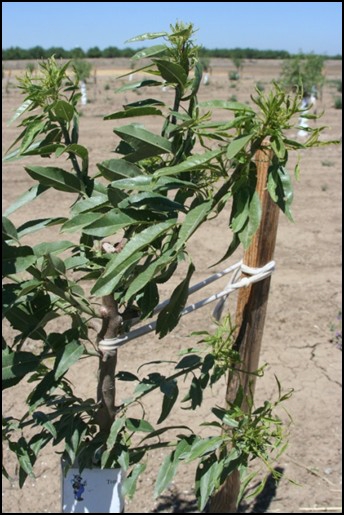In June we visited a first-leaf almond orchard that had started the season growing normally, but as the root system expanded, the trees’ growth became rapidly stunted (Fig. 1). The newly expanding shoot tips showed ‘little leaf’ symptoms (Fig. 2) characteristic of glyphosate injury, with an incredible proliferation of shoots (Fig. 3) growing from the same point on the scaffolds.



After investigating crop rotations, we learned that the trees showing symptoms had followed alfalfa newly planted the previous year that had been removed after only one year. Trees from the same nursery and farmed by the same grower were planted on the other half of the ranch in ground following three years of alfalfa (planted in 2009) but did not show any symptoms. The trees showing injury were planted 12 months after the herbicide imazethapyr (Pursuit) was used. Pursuit is a widely used herbicide in seedling alfalfa. Uptake of the herbicide occurred following the most recent irrigation where herbicide mobilization and expanding roots came into contact.
Documented symptoms of imazethapyr injury include stunted growth, small leaves, and the formation of adventitious buds and multiple shoot growth. These symptoms can occur as early as 14 days after use or remain in the soil for months after application and still be a problem. Imazethapyr is an amino acid synthesis inhibitor herbicide that can persist in soil for up to 40 months de-pending on irrigation practices, crop rotations, and soil pH. Crop rotation restrictions range from 0 days to 40 months and are specific for the crop being planted.
Typically, Pursuit is not used on 2nd and 3rd year alfalfa because of its soil persistence issues having the potential for injury to subsequent crops. Nutsedge and other weeds were noticeably absent from the block treated with Pursuit which is not surprising, since it does have excellent broadleaf weed control capabilities. Young almonds are clearly susceptible to imazethapyr and other herbicides with a similar mode of action and almonds should not be planted following their use unless label restrictions are thoroughly reviewed and fully met.